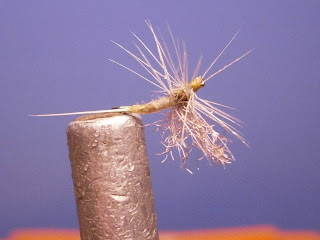The Galloup's cripple was designed to show the radius of the natural and to show a single wing. It has great imprint on the water. Kelly Galloup is the creator and you can find out more about the pattern in his book Cripples and Spinners. It is an excellent book, I highly recommend it to anyone who likes to match the hatch.
 |
| Biot and cdc |
I have used this pattern on several hatches and it works very well. There are several variations to the fly. The original is done with dubbed body and high-vis(z-lon) for the wing. It is also done with a biot body and a cdc wing. All variation are effective. I like the dubbed bodies and i like to do a snowshoe wing. I do tie and fish the z-lon winged often as well and the biot and cdc.
Lets twist one up
Materials- This one is my bwo recipe.
Hook- daiichi 1170 Good deals on these from my sponsor. check him out.
Thread-8/0 uni light olive
 |
| Thread abdomen, dubbed thorax, with grey z-lon |
Tail- dun hackle fibers
Abdomen- Blue-dun superfine
Wing- Grey z-lon.
Thorax-blue dun/olive brown superF
Hackle- Dun rooster **2x over sized
 |
| Bend your hook shank like so. Do it with your jaws of your vise open. Put a nice even bend in it. Dont put a tight bend. |
 |
| Start the thread and taking touching turns back to the barb. |
|
|
 |
| Get yourself some hackle fibers, take note of the way they naturally curved. Keep them in order. |
 |
| Measure the tales, they should be equal to the hook shank length. Take one turn over the cluster and one turn under, then a turn over. This will splay the tails and raise them up. |
 |
| Dub the abdomen. The trick here is to use as least amount of dub as possible. You want the olive thread to bleed through when wet. |
 |
| Tie in a length of Z-lon for the wing. Tie in on like you would spinner wings. You only 1 figure 8 wrap to hold it. Wrap tight. |
 |
| Trim the far side wing. |
 |
| Select a hackle that is 2x larger than you would normal use for the size your tying. I am tying a #16 here. So i have a size 12 hackle. Tie in on top of the hook shank. Good side up. |
 |
| Dub the thorax. I like to use 1 pinch blue dun and one pinch brown olive super fine. I hand blend it in my hands pulling it and stacking and pulling...... Dub it as tight as possible using as little as possible. When tying a dry fly its good to dub tightly, and use the least amount of wraps possible. |
 |
| Wind the hackle. Take one complete turn behind the wing, one in front and then one in front of that. IF you are using whiting hackle i would say to do only 2 turns. Catch the hackle stem with the thread. |
 |
| Keeping the thread tight, pull the hackle stem back and take a turn over it. This is how you get the atenna on the fly. You can skip this step. The trout dont mind. It does however give the fly a little more floation and it they look nice. :) |
 |
| Trim your hackle stem away, and make a nice neat small head. whip finish. Trim the thread |
 |
| Trim all the hackle from the bottom of the fly. Nice and close. I have had picky trout refuse a fly because of barbs left from the hackle being trimmed. So get it all the way down. |
 |
Take the wing and pull it back, dont pull that you cause the zlon to stretch. Once you cut it will spring back causing your wing to be shorter. So gentle pull it back and trim it in line with the back of the bend.
|
 |
| You can once the inital trim is done, model your wing. Its not really necessary, but i like to think it makes a difference. The fly is complete. |
 |
| The fly "in the film" You can see the thread has bleed through. I find this color is a very close match for the bwos in western nj and eastern pa area. |
 |
| As you might have already thought, this baby is deadly and is a tough one to see in the film when fishing. |




















Wonderful tutorial.
ReplyDeleteGood looking fly. Great tutorial. Keep them coming.
ReplyDelete